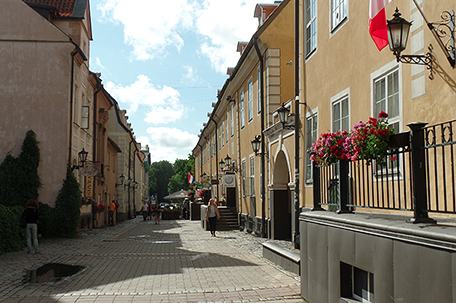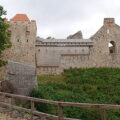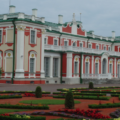
ABOVE PHOTO: Riga Historic District
By Renée S. Gordon
Riga, Latvia, the largest city in the Baltics, was awarded the title of European Capital of Culture in 2014 and it deserves the honorific. Riga is also widely regarded ”The Paris of the Baltics” and it boasts outstanding architecture, trendy and traditional restaurants, world-class accommodations, shopping for cutting edge designs and chic nightlife, all available at rates far more affordable than other destinations. There are few other places in the world where the historic blends with and is enhanced by the contemporary. The region’s history can be traced through the architectural styles that encompass structures from the late-1400s medieval core and more than 300 Art-Deco buildings throughout the city.
Riga is located where the Daugava and Ridzene Rivers meet and there were colonies of Livs and Cours living at this strategic point for hundreds of years. Pre-dating the formal establishment of the city was a settlement of German merchants and a monastery, constructed in 1190, by the Augustinian monk Meinhard who Christianized the region. Nine years later Bishop Albert became Bishop of Livonia and in 1201 he sailed into Riga’s harbor with more than 1500 crusaders. With the Germans came knowledge of building with stone and they constructed a wall and two castles, one for Bishop Albert and one for the crusaders. The city became independent in 1221 and thrived to such an extent as a center of trade that it became a member of the Hanseatic League in 1282. Riga was constantly invaded until 1710 when it became part of the Russian Empire. In 1918 the First Republic of Latvia was declared.
The Historic Center of Riga was designated a UNESCO World Heritage Site in 1997. The medieval portion of the city is situated on the right shore of the Daugava River and was originally laid out in the standard pattern with a town square at the center with narrow winding streets radiating outward. During the Russian Empire period Riga was the 5th largest city and the largest port in Russia and during this time the city grew and many of its grand stone buildings were constructed.
Riga Canal forms a two mile boundary between Old Town and the City Center with access via 16 bridges. Originally the canal and moats were part of the fortifications that kept the city safe but in the mid-1850s they were turned into a recreation area. A complete restoration was undertaken in 2001. Canal boat tours are available and are an excellent way to sightsee and get out on the river. rigabycanal.lv/en
Riga Old Town Square has been the heart of the city since the 13th-century. It was destroyed during WWII but has been restored with cobblestones indicating which buildings once stood there. The restored three story Town Hall on the square served as the Riga Town Hall until 1889 and the 20-ft. statue of Roland that stands in the center of the square was placed there in 1896. Executions were once held on the square and judgments were determined in Town Hall. Roland is considered a symbol of fairness and is the defender of the accused so he faces Town Hall. The top of Roland’s sword is the point from which distances to other cities is measured. The current statue is a replica.
One of the most stunning structures in Riga is the House of Blackheads. The building, dating from 1344, was totally destroyed in 1941 and was meticulously reconstructed in 1999. This Dutch Renaissance historic building was the headquarters of unmarried merchants whose patron saint was Maurice, an African Roman legionnaire, hence the name Blackheads. The Blackheads purchased the building in 1713 and in addition to the beautiful exterior the interior features magnificent ceiling paintings. The building also hosted concerts by Liszt and Wagner. melngalvjunams.lv
Also on the square is St. Peter’s Church, the tallest in Riga, first documented in 1209. The earliest church was wooden but was replaced by a Gothic red brick structure. Originally Catholic, in 1523 it became Lutheran. The tower has been reconstructed a number of times beginning in 1666. The Baroque tower was destroyed in 1941 and was restored in the 1970s. The church has one of the Riga’s best viewpoints, a 236-ft. observation tower that is accessible by elevator. vecriga.info
St. John’s Church began as a Dominican monastery in 1234. During the 15th-century two monks were voluntarily walled up in hopes of becoming saints, leaving only a small window to pass through food and drink. Today a cross-shaped section with bars indicates the spot. The Dominicans were expelled and in 1582 the church became part of the Latvian parish. Because the church was destroyed several times it is comprised of a number of styles of architecture with the dominant style being high Gothic. The tower dates from 1849. A 36-ft. high portion of the original wall can be seen in the churchyard. St. John’s is the oldest church in the city.
Swedish Gate was carved through an existing house in 1698 as a section of the wall encircling Old Riga. It is one of only two gates to remain in its original form. The city executioner lived in an apartment above the gate and it was his habit to place a rose in his window on the eve of an execution so that people could attend if they wished.
The Three Brothers are three residences in a row that are the oldest stone homes and represent building styles over an extended period. The oldest house, #17, dates from the 15th-century, the middle home, #19, is from 1646 and the last of the three is #21. The houses were restored in the 1950s and #19 now features The Riga Museum of Architecture. The buildings are located on Mazā Pils Street.
Dome Square was an important site during the Latvian National Independence Movement that began in 1987 and gained momentum in 1988 under the leadership of the People’s Front of Latvia. In 1991, Barricades were erected all around the Old City and many citizens came out to man them. Commemorative events continue to be held on the square.
Construction on the Dome Church began in 1211 by Bishop Albert. The church was built over a number of years and exemplifies many architectural styles. The current church dates from 1776 and it is the largest church in the Baltics. The altar is Romanesque, the Basilica is Gothic and the 295-ft. spire is Baroque. There has been an organ inside the church since 1601. The current 6.718 pipe organ was dedicated in 1884 and was once the largest in the world. No less a person than Franz Liszt wrote a special work “Nun danket alle Gott” for the dedication.
The original castle in Riga was constructed in 1209 by the Order of the Sword Brothers and called Wittenstein, meaning “white stone” but the current Riga Castle was founded by the Livonian Order in Castle Square in 1330. It was destroyed and reconstructed in 1515. The castle was always a secular stronghold situated to monitor the trade on the Daugava River. The 1330 structure was a basic square with four towers and three floors and in the mid-1800s a stone gallery was added. In 1922, one wing of the castle became the residence of the President of Latvia while another wing houses the National Museum of History of Latvia.
Robert Pflug and Janis Baumanis, Latvia’s first academically trained architect, designed the Latvian Parliament, the Saeima. The 1867 Vidzemes Knightly House, originally constructed for the Livonian Order, was expanded at the turn of the 20th-century, reconstructed in 1923 and again in 1998. The exterior of the building is in the Eclecticism architectural style with interiors of varying styles considered some of the most striking in any of the city’s public buildings.
Riga’s Art Nouveau architecture has been deemed “unparalleled anywhere in the world” by UNESCO and Riga has the largest number of Art Nouveau buildings in Europe. There are 50 buildings in the medieval district and more than 300 throughout the Historic Center. International visitors head straight for the Art Nouveau District for a walking tour. One of the highlights of the tour is the row of five houses designed by Mikhail Eisenstein, father of the famous Russian director Sergei Eisenstein. Each house is different and equally fanciful.
Museum Riga Art Nouveau Center is located inside the former apartment of Architect Konstantins Peksens. The guided tour begins when visitors select an ornate hat from the era to wear as they walk through the 13-room apartment. The building was very modern when it was built in 1903 and included central heating and hot water. The rooms are fully furnished with authentic furniture, tiles, artwork and tableware. Jugendstils.riga.lv
The Museum of the Occupation of Latvia, one of the country’s largest museums, is temporarily housed in the former United States Embassy. The museum tells the story of Latvian occupation by the Soviets and the Germans from 1940 until they gained their independence on August 21, 1991. The story is vividly interpreted through video, photographs, artifacts and guided tours. The museum is basically chronological with smaller displays on highlighted topics.
The story of the Latvian Jews is especially well and unblinkingly articulated. When the Nazi’s marched into Latvia in 1941 they began the methodical murder of Gypsies and Jews and during the World War II years more than 85,000 Latvian Jews and Gypsies were murdered in concentration camps. In November and December 1941 the Nazi’s took 26,000 Jews into the Rumbula Forest just outside the city and executed them. Ghettos were established in Riga and both Latvian and German Jews were held there. In 1943, Kaiserwald concentration camp was established in the city and the ghetto was destroyed. Occupationmuseum.lv
One of the things Riga is renowned for is its culinary use of fresh and local ingredients. Chefs and housewives alike are among the more than 80,000 people who daily shop at Central Market located on the shores of the Daugava River. After WWI it was decided to expand the market and this was done in a unique way. Five of the Kaiser’s WWI zeppelin hangars were relocated to Riga to serve as market pavilions. The hangars are 787-ft. long, 150-ft wide and 124-ft. high making the market one of the largest in Eastern Europe. Guided tours of the market are offered and visitors have an opportunity to purchase and taste artisanal products and traditional foods like the tasty potato and carrot pastry “sklandrausi.” Other vendors on the premises sell jewelry, clothing, antiques, housewares and flowers. www.rct.lv/en
Just as Riga is known as the “Paris of the Baltics,” so Rundāle Palace is recognized as the “Versailles of Latvia.” Rundāle is located less than an hour from the city. The Grotthus family owned Rundāle more than 200-years before Johann Biron acquired the land in 1735. He was a favorite of the daughter of Ivan V, half-sister of Peter the Great, Empress of Russia, Anna Ivanovna. Because of their “friendship” Empress Anna hired Francesco Bartolomeo Rastrelli as the architect for the palace he was to build at Rundāle. Rastrelli’s previous commissions included the Winter Palace and the Peterhof in St. Petersburg and the Catherine Palace in Tsarskoe Selo. He designed the 138-room summer residence as a magnificent Baroque and Rococo masterpiece complete with a Baroque formal garden, park, rose garden and maze.
Tours of the interior will take your breath away as walk through the public and private spaces. The ceiling painting in the Grand Gallery took 14 years to restore. The White Hall is so called because of its color, designed for dancing and showcasing the vivid colors worn by the guests. It is one of the best examples of a Rococo interior in the world. The room that evokes the biggest reaction is the Gold Hall with its allegorical ceiling painting, gold leaf gilding and parquet from the 1760s.
Because Rundāle was severely damaged in WWII it was declared a museum in the 1970s and extensive restoration began. Construction of the palace took four years and the restoration has lasted more than 40 years. Only a limited number of rooms are open for tours but Rundāle is must see site. Rundale.net
While in Riga the Wellton Centrum Hotel & Spa is an ideal choice for accommodations. Originally an 1873 publishing house designed by Otto Dietze, today it is a modern hotel offering spa services and 120 eco-Scandinavian decorated rooms with views of Old Riga. wellton.com
When planning your next vacation look east. Eastern Europe is filled with history, outdoor activities and modern conveniences. You can party all night and indulge in luxurious spa treatments all day. Best of all, Estonia and Latvia are very affordable and the vast majority of people speak English. I think you should discover them now just as I did! www.visitestonia.com/en and www.latvia.travel
TRAVEL TIPS:
The Penn Museum will present series of programs in the international galleries this fall.
Programs are designed to interest all ages and encourage learning and interaction. Admission to programming is free with admission. Admission is free for children 6 and under, active U.S. military and PennCard holders. Online pre-registration and all dates and detailed information is available online.
www.penn.museum/calendar.

















Leave a Comment